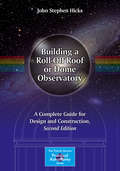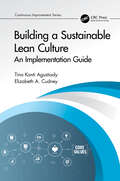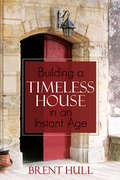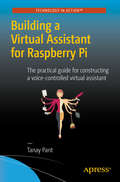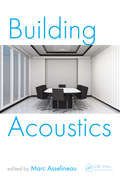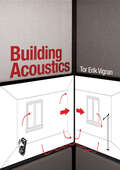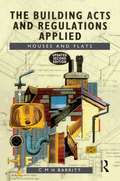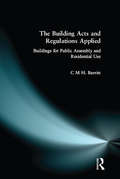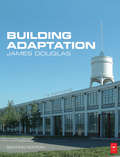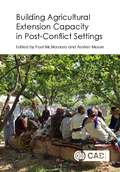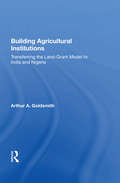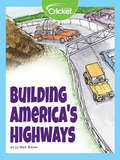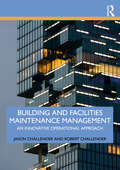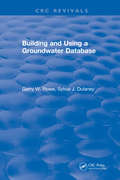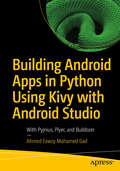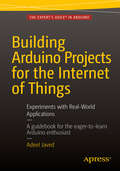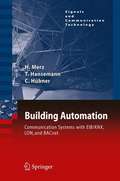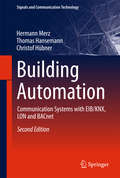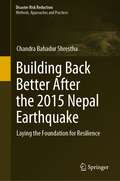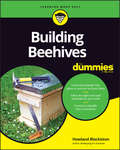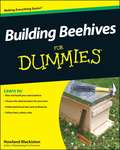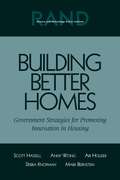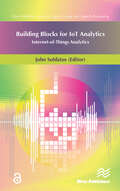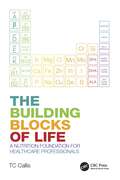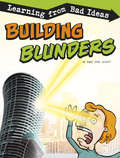- Table View
- List View
Building a Roll-Off Roof or Dome Observatory: A Complete Guide for Design and Construction (The Patrick Moore Practical Astronomy Series)
by John Stephen HicksAlmost every practical astronomer eventually aspires to have a fixed, permanent observatory for his or her telescope. A roll-off roof or dome observatory is the answer for the most popular home observatory design. Building a Roll-Off or Dome Observatory will help you decide whether to embark on the venture and will certainly increase your enthusiasm for the project. The author, both an amateur astronomer and a professional landscape architect, answers many of the common questions asked about observatory construction, covering the following topics: * Zoning, and by-law requirements common to most states, towns and municipalities * Where to locate the observatory * How to tailor the observatory for your particular needs * Tools and structural components required * Possible variations in design * How to combine the structure with other structures (incorporating a garden patio under the gantry in the roll-off roof observatory, for example) This fully detailed outlines step-by-step construction, with professional detailed diagrams for each phase of construction.
Building a Sustainable Lean Culture: An Implementation Guide
by Tina Agustiady Elizabeth A. CudneyThis book is an implementation guide for creating a Lean Culture from the ground up while gaining buy-in from key stakeholders and being able to sustain the results. Everyone talks about implementing a Lean Culture, but only provides Lean Tools for the implementation. This book discusses implementing the entire system from three main aspects. It will cover the people (structural and cultural), the operation system, and the tools. Also included is a full set of case studies to show real-life implementations as well. This text- Discusses Leader Standard work for all employees Covers the escalation process for tiers and daily accountability Shows how to deal with a change of SOP's and standardization within an organization Presents exercises for Lean Tools Implementation Offers real-life case studies of implementing a lean culture while sustaining it Building a Sustainable Lean Culture: An Implementation Guide discusses Lean Leadership from a managerial standpoint and ensures the lean journey does not fail through accountability, standardized work, and technological advances utilizing Lean Systems. Useful in manufacturing, services, IT, and healthcare, this book includes the implementation of empowering employees to want to build a Lean Culture.
Building a Timeless House in an Instant Age
by Brent HullThe author of Traditional American Rooms examines the evolution of home construction, making a case against mass-produced homes.HISTORY®’s Lone Star Restoration star, Brent Hull is a master craftsman, and hands-on preservationist. Hull—a Foreword Reviews Book of the Year Finalist for architectural non-fiction—challenges us to consider the impact our decisions will have when building a house. What do our homes say about us? What stories are they telling? Are they declarations of integrity, beauty, and heritage? Or do they suggest we have lost our sense of value, craft, and harmony?Nationally recognized as an authority on historic design, architecturally correct moldings, and millwork, Hull is uniquely qualified to speak to the craft of building and art of design. In an age of “instant”‘ homes, how do we build something timeless that weaves a tale of character, values, history, and heart? The decisions we make for our homes are not inconsequential. What we build defines us. In fact, the contrast between the way we build today and how structures used to be built has become only more vivid. What happened to craft? What happened to the art of building? Our values and what we believe about life have changed as well. We have come to see houses as a tradable commodity. We live in a time that is obsessed with “what’s next?” We need to be careful of fooling ourselves into thinking that a bottom-line mentality is the best way to approach building a home. Now is the time to examine ourselves, our motives, and our hearts.Praise for Building a Timeless House in an Instant Age“Part call to action, part exploration of technique, the result is a persuasive and enjoyable reminder that our homes are reflections of ourselves . . . . A pleasing, educational look at traditional home construction.” —Kirkus Reviews
Building a Virtual Assistant for Raspberry Pi: The practical guide for constructing a voice-controlled virtual assistant
by Tanay PantBuild a voice-controlled virtual assistant using speech-to-text engines, text-to-speech engines, and conversation modules. This book shows you how to program the virtual assistant to gather data from the internet (weather data, data from Wikipedia, data mining); play music; and take notes. Each chapter covers building a mini project/module to make the virtual assistant better. You'll develop the software on Linux or OS X before transferring it to your Raspberry Pi, ready for deploying in your own home-automation or Internet of Things applications. Building a Virtual Assistant for Raspberry Pi walks you through various STTs and TTSs and the implementation of these components with the help of Python. After that you will start implementing logic for handling user queries and commands, so that the user can have conversations with Melissa. You will then work to improve logic handling to detect what the user wants Melissa to do. You will also work on building some useful applications/modules for Melissa, which will allow you to gain interesting information from Melissa such as the time, weather information, and data from Wikipedia. You will develop a music playing application as well as a note taking application for Melissa, laying the foundations for how Melissa can be further extended. Finally, you will learn how to deploy this software to your Raspberry Pi and how you can further scale Melissa to make her more intelligent, interactive and how you can use her in other projects such as home automation as well. What You'll Learn Design the workflow and discover the concepts of building a voice controlled assistantDevelop modules for having conversations with the assistantEnable the assistant to retrieve information from the internetBuild utilities like a music player and a note taking application for the virtual assistantIntegrate this software with a Raspberry Pi Who This Book Is For This book is for anyone who has built a home automation project with Raspberry Pi and now want to enhance it by making it voice-controlled. The book would also interest students from computer science or related disciplines.
Building Acoustics
by Marc AsselineauAvoid Costly Mistakes for Specialists and Non-Specialists AlikeBad acoustics in buildings is a nuisance that is not dealt with easily. The problem applies just as much to open-plan offices and restaurants and to production facilities and transportation stations as it does to performance halls, not to mention homes. It does not merely affect oral co
Building Acoustics
by Tor Erik VigranBuilding or architectural acoustics is taken in this book to cover all aspects of sound and vibration in buildings. The book covers room acoustics but the main emphasis is on sound insulation and sound absorption and the basic aspects of noise and vibration problems connected to service equipment and external sources. Covering all aspects of sound and vibration in buildings, this book explores room acoustics, sound insulation, and noise and vibration problems connected to service equipment and external sources.
The Building Acts and Regulations Applied: Houses and Flats
by C.M.H. BarrittThis newly revised edition is an up-to-date and concise volume, clarifying the Building Acts and Regulations relating to houses, flats and maisonettes, for all construction professionals and students.Each chapter forms a self-contained unit covering all the regulation requirements applicable to a particular part of a building, dealing with each part in turn. With this single volume, professionals can ensure that all regulations are fully covered in respect of houses, flats and maisonettes. Inclusion of the July 1995 changes in the Acts and Regulations ensures the text provides the very latest information.An ideal reference book for architects, builders, structural and building services engineers. Essential supplementary reading for students undertaking courses in any of the above at HNC, HND and degree level.
The Building Acts and Regulations Applied: Buildings for Public Assembly and Residential Use
by C.M.H. BarrittThis book forms part of a unique, highly practical and time-saving three volume presentation of the Building Regulations, each book covering all the regulations relating to specific building usage. The chapters of each volume form self-contained units covering all the Regulation requirements applicable to a particular part of a building; thus the reader can ensure that all the Regulations are fully met. Also included is a digest of published standards, guides and technical information as well as reviews of the new Eurocodes currently being introduced.The Building Acts and Regulations Applied: Buildings for Public Assembly and Residential Use covers all the regulations relating to buildings used for public assembly or residential purposes (other than houses and flats), such as theatres, sports stadia, hotels, prisons and halls of residence. It is a useful course companion for BTEC HNC/D and degree courses in building, architecture, surveying, estate management and other built environment disciplines. It is also an ideal reference source for all professionals working in these areas.
Building Adaptation
by James DouglasAs existing buildings age, nearly half of all construction activity in Britain is related to maintenance, refurbishment and conversions. Building adaptation is an activity that continues to make a significant contribution to the workload of the construction industry. Given its importance to sustainable construction, the proportion of adaptation works in relation to new build is likely to remain substantial for the foreseeable future, especially in the developed parts of the world.Building Adaptation, Second Edition is intended as a primer on the physical changes that can affect older properties. It demonstrates the general principles, techniques, and processes needed when existing buildings must undergo alteration, conversion, extension, improvement, or refurbishment.The publication of the first edition of Building Adaptation reflected the upsurge in refurbishment work. The book quickly established itself as one of the core texts for building surveying students and others on undergraduate and postgraduate built environment courses.This new edition continues to provide a comprehensive introduction to all the key issues relating to the adaptation of buildings. It deals with any work to a building over and above maintenance to change its capacity, function or performance.
Building Agricultural Extension Capacity in Post-Conflict Settings
by Paul E. Mcnamara Austen MooreThis book (a) investigates the experiences and issues involved with extension systems in post-conflict settings, (b) evaluates the impact of different extension policy approaches and practice in such settings, and (c) identifies the key elements needed to effectively rebuild agricultural extension systems and programs in post-conflict contexts. The chapters contain country-specific case studies that provide a descriptive account but also analyze strategies, successes and failures, and lessons learned. A synthesis chapter provides comparative analysis of insights across post-conflict settings. Overall, the book serves as a collective volume for use by governments, practitioners, and academics in extension policy-making and programming, and contributes to post-conflict, political science, and agricultural extension literatures.
Building Agricultural Institutions: Transferring The Land-grant Model To India And Nigeria
by Arthur A GoldsmithShortly after World War II the United States began to export to developing countries the ''land-grant model"-its system of applied agricultural science. This system is made up of subnational agricultural universities, extension services, and experiment stations, and also of national-level organizations to support and coordinate agricultural develop
Building America's Highways
by Mark BrewerPeople across the country worked together to improve the roads of America.
Building and Facilities Maintenance Management: An Innovative Operational Approach
by Jason Challender Robert ChallenderBuilding and Facilities Maintenance Management: An Innovative Operational Approach is a new introductory textbook aimed at students who are studying building maintenance and asset management for the first time as part of their undergraduate or foundation course. The book plugs a gap in the current curriculum and literature which must now seek to educate emerging professionals about the significance of the operational phase of a built asset’s lifecycle, if the challenges of the day are to be met head on.Each chapter is supported by seminar questions and formative assessment tasks to allow the learner to assess their own progress through the text and covers: The nature and importance of building maintenance for the successful strategic operation of an estate contracting and procurement of maintenance works risk assessment in maintenance management surveying for common maintenance issues and defects the relationship between maintenance management and environmental sustainability and maintenance and conservation of historic buildings The book will help readers enhance their awareness, understanding and breadth of knowledge of the issues around improving organisational maintenance management. A handy guide for emerging professionals, this practical book is also ideal reading for anyone studying facilities management, building surveying, construction management, real estate and property management.
Building and Using a Groundwater Database
by Garry RoweBuilding and Using a Groundwater Database is an introductory book that focuses on the fundamentals of groundwater database use. It is an excellent guide for people who collect and use groundwater quality data, hydrogeological data, and general geological data, as well as people who are required to prepare information about groundwater resources for others to use. The book also serves as a textbook for computer-based hydrogeology courses. Many university courses now make use of computerized groundwater data, yet no textbook exists to guide students in database use.Building and Using a Groundwater Database provides detailed information regarding the steps and perspectives required to create a database and use it for groundwater management, land use practices, planning, cleanups, site investigations, and general hydrogeologic reporting. The book is structured to take the reader from the foundations of database development through maintenance and everyday use of the database. Actual examples from selected case studies are used to illustrate database principles. This book is unique in that it deals with the management and structuring of groundwater data, as opposed to the collection and interpretation of data. It illustrates how database software managers can be integrated with groundwater software tools. Building and Using a Groundwater Database provides consultants, engineers, public officials, university instructors, local and municipal water utilities, and banking and loan institutions with a clear, concise guide to using groundwater databases.
Building Android Apps in Python Using Kivy with Android Studio: With Pyjnius, Plyer, and Buildozer
by Ahmed Fawzy GadStart building Python-based Android applications using Kivy with Android Studio. Through in-depth examples, this book teaches you everything you need to create your first Android application in Python and publish on Google Play.Building Android Apps in Python Using Kivy with Android Studio takes you through the basics of Kivy by discussing its application structure, widgets, and event handling. The KV language is then introduced for separating the logic and GUI by adding widgets within a KV file. You will then learn how to utilize Android camera using Kivy, build the HTTP server using Flask, and create and manage multiple screens to help you design your own applications. Through detailed step-by-step instructions, you will create your first multi-level cross-platform game that includes animation and sound effects. Following this, the process of converting the Kivy application into an Android application using Buildozer and Python-4-Android is covered in detail. You will then learn how to edit the generated Android Studio project into Android Studio by adding extensions to the original application. The widgets added in Kivy could be handled within Android Studio. Moreover, Android views could be added to enrich the Kivy application. The resulting Android application created with Kivy can be hosted on Google Play to download and install as a regular Android application.At the end, this book will give you the basic knowledge of Kivy needed to build cross-platform Android applications, produce an Android Studio project, and understand how it all works in detail. What You Will LearnBuild cross-platform applications from scratch using Kivy in detailCreate a cross-platform interactive multi-level game from the ground upExamine the pipeline of building an Android app from the Python Kivy appUnderstand the structure of the Android Studio project produced by KivyRecognize how to extend the application within Android Studio by adding more Android views to the application main activity. Who This Book Is ForPython developers with no previous experience in Kivy who are looking to create their first Android application completely in Python.
Building Arduino Projects for the Internet of Things: Experiments with Real-World Applications
by Adeel JavedThis is a book about building Arduino-powered devices for everyday use, and then connecting those devices to the Internet. Connected devices allow for applications to be built around the connectivity benefits, a trend commonly referred to as The Internet of Things (IoT). The connectivity between devices is where the action lies today. If you're one of the many who have decided to build your own Arduino-powered devices for IoT applications, you've probably wished you could find a single resource--a guidebook for the eager-to-learn Arduino enthusiast--that teaches logically, methodically, and practically how the Arduino works and what you can build with it. Building Arduino Projects for the Internet of Things: Experiments with Real-World Applications is exactly what you need. Written by a software developer and solution architect who got tired of hunting and gathering various lessons for Arduino development as he taught himself all about the topic, this book gives you an incredibly strong foundation of Arduino-based device development, from which you can go in any direction according to your specific development needs and desires. Readers are introduced to the building blocks of IoT, and then deploy those principles to by building a variety of useful projects. Projects in the books gradually introduce the reader to key topics such as internet connectivity with Arduino, common IoT protocols, custom web visualization, and Android apps that receive sensor data on-demand and in realtime. IoT device enthusiasts of all ages will want this book by their side when developing Android-based devices. What You'll Learn: Connect an Arduino device to the Internet Creating an Arduino circuit that senses temperature Publishing data collected from an Arduino to a server and to an MQTT broker Setting up channels in Xively Setting up an app in IBM Bluematrix Using Node-RED to define complex flows Publishing data visualization in a web app Reporting motion-sensor data through a mobile app Creating a remote control for house lights Creating a machine-to-machine communication requiring no human intervention Creating a location-aware device ket="" of="" new="" enthusiasts="" all="" ages="" who="" are="" just="" starting="" out="" with="" iot="" device="" development.
Building Automation: Communication systems with EIB/KNX, LON and BACnet (Signals and Communication Technology)
by Christof Hübner James Backer Leena Greefe Thomas Hansemann Viktoriya Moser Hermann MerzModern buildings are increasingly equipped with actuators and sensors, communication, visualization and control systems. This textbook provides an overview of industrial communication systems and stimulates a basic understanding of network and bus systems for the automation of buildings. After an introduction to EIB/KNX, LON und BACnet technologies, the authors illustrate how these systems can be utilized for specific applications, like air conditioning or illumination. This book assumes only a basic knowledge of mathematics and thanks to its simple explanations and many examples is ideal for students and professional engineers who require practical solutions.
Building Automation: Communication Systems With Eib/knx, Lon And Bacnet (Signals And Communication Technology)
by Christof Hübner Thomas Hansemann Hermann MerzThis book offers all important industrial communication systems for buildings in one single book! It stimulates a basic understanding of network and bus systems for the automation of buildings. After an introduction to EIB/KNX, LON und BACnet technologies, the authors illustrate how these systems can be utilized for specific applications, like air conditioning or illumination. This book assumes only a basic knowledge of mathematics and thanks to its simple explanations and many examples is ideal for students and professional engineers who require practical solutions.Numerous practical examples explain basic concepts of industrial communication technology as well as the procedure for the transmission of digital data. All chapters have been thoroughly revised for the 2nd edition and the book includes the latest technical developments and standards.
Building Back Better After the 2015 Nepal Earthquake: Laying the Foundation for Resilience (Disaster Risk Reduction)
by Chandra Bahadur ShresthaThis book explores the reconstruction after the 2015 Gorkha Nepal earthquake, on the basis of the author’s first-hand experience that has been validated with empirical evidence. Unlike other advocacy and academic literature, the book takes readers close to the ground where the activities took place. This book describes Nepal’s efforts to rebuild private housing from the preparatory to the concluding stages, and the obstacles faced and overcome along the way. It assesses the consequences of the policy level decisions and also examines the relevance, utility and future use of damage assessment surveys that were carried out in the country. In addition, lessons from the housing grant payment through the banking system, impending reasons for housing non-compliance to building standards, experimentation with resilient resettlements and unresolved issue of urban regeneration have been also delved in. The ground realities revealed that the aid architecture requires further carving out. The last three chapters have attempted to capture the macro level picture of the reconstruction and recovery endeavors: contribution to national economy, structural resilience and comparative overview of Nepal’s delivery in global context. As an intimately involved professional with the 2015 Nepal Earthquake, Dr Shrestha is the authority from whom a holistic understanding can be attained regarding the response of Nepal's state and society to the Earthquake. His study will have ramification at national and global scale in handling with inescapable natural calamities. Kanak M. Dixit, Journalist and Heritage ConservationistDr. Shrestha’s book provides rare insight and perspective on the issues and challenges of governance during the complex journey to reconstruction and future resilience, reflecting his long and intense engagement in the post disaster recovery and reconstruction. Vivek Rawal, Director, People-in-Centre, Ahmedabad, India This collection of balanced insightful essays methodically explores topics such as government decisions and aid during the earthquake recovery combining lived experience and a research approach to reveal lessons and future considerations. Loren Lockwood, Former National Coordinator, &n
Building Beehives For Dummies
by Howland BlackistonBuilding Beehives For Dummies (9781119544388) was previously published as Building Beehives For Dummies (9781118312940). While this version features a new Dummies cover and design, the content is the same as the prior release and should not be considered a new or updated product. The easy way to build your own beehives and beekeeping equipment Building Beehives For Dummies is the follow-up book to the bestselling Beekeeping For Dummies. It provides everything you need to learn how to build some of the world's most popular hives and beekeeping accessories. For each design the book includes a detailed materials list (what lumber, hardware and fasteners you'll need), step-by-step building instructions, and illustrative drawings that show how the components all fit together. There are over a dozen plans in all, including the traditional Langstroth hive, the eight frame garden hive, designs for elevated hive stands, the Warre hive, screened bottom board, the Kenya top-bar hive, four-frame observation hive, hive top feeders, and more. The book contains introductory chapters that teach you the basic carpentry skills necessary to build any of the plans in the book. Whether you are a new beekeeper or a seasoned ol’timer, Building Beehives for Dummies provides you with the information you need to plan and succeed at building beehives (and other cool accessories). You'll discover what type of hive to build, hints on how to maintain your equipment, what bees need to stay happy and healthy, where to locate your hive, and much more. Covers "bee space," the critical technical measurement within a beehive that's crucial for easy inspection of your colonies Offers guidance on keeping both urban and suburban neighbors happy, getting proper permissions, and understanding regional laws and regulations Provides creative ideas for dressing up hives for fun and profit In today’s world of self-sufficiency, back-to-basics and sustainability, building beehives is a fun hobby that both you and your bees will appreciate and benefit from.
Building Beehives For Dummies
by Howland BlackistonThe easy way to build your own beehives and beekeeping equipmentBuilding Beehives For Dummies is the follow-up book to the bestselling Beekeeping For Dummies. It provides everything you need to learn how to build some of the world's most popular hives and beekeeping accessories. For each design the book includes a detailed materials list (what lumber, hardware and fasteners you'll need), step-by-step building instructions, and illustrative drawings that show how the components all fit together. There are over a dozen plans in all, including the traditional Langstroth hive, the eight frame garden hive, designs for elevated hive stands, the Warre hive, screened bottom board, the Kenya top-bar hive, four-frame observation hive, hive top feeders, and more. The book contains introductory chapters that teach you the basic carpentry skills necessary to build any of the plans in the book. Whether you are a new beekeeper or a seasoned ol'timer, Building Beehives for Dummies provides you with the information you need to plan and succeed at building beehives (and other cool accessories). You'll discover what type of hive to build, hints on how to maintain your equipment, what bees need to stay happy and healthy, where to locate your hive, and much more.Covers "bee space," the critical technical measurement within a beehive that's crucial for easy inspection of your coloniesOffers guidance on keeping both urban and suburban neighbors happy, getting proper permissions, and understanding regional laws and regulationsProvides creative ideas for dressing up hives for fun and profitIn today's world of self-sufficiency, back-to-basics and sustainability, building beehives is a fun hobby that both you and your bees will appreciate and benefit from.
Building Better Homes
by Ari Houser Debra Knopman Mark A. Bernstein Anny Wong Scott HassellThis report examines the structure, characteristics, and motivations of major participants in the housing industry to explore how innovation might be accelerated. It identifies options and strategies for the federal government to consider as it attempts to further advance innovation in housing to make homes more affordable, durable, and safe. Innovation in housing would provide benefits to a broad range of participants, including homebuilders, manufacturers, insurers, regulators, and homeowners.
Building Blocks for IoT Analytics Internet-of-Things Analytics
by John SoldatosInternet-of-Things (IoT) Analytics are an integral element of most IoT applications, as it provides the means to extract knowledge, drive actuation services and optimize decision making. IoT analytics will be a major contributor to IoT business value in the coming years, as it will enable organizations to process and fully leverage large amounts of IoT data, which are nowadays largely underutilized. The Building Blocks of IoT Analytics is devoted to the presentation the main technology building blocks that comprise advanced IoT analytics systems. It introduces IoT analytics as a special case of BigData analytics and accordingly presents leading edge technologies that can be deployed in order to successfully confront the main challenges of IoT analytics applications. Special emphasis is paid in the presentation of technologies for IoT streaming and semantic interoperability across diverse IoT streams. Furthermore, the role of cloud computing and BigData technologies in IoT analytics are presented, along with practical tools for implementing, deploying and operating non-trivial IoT applications. Along with the main building blocks of IoT analytics systems and applications, the book presents a series of practical applications, which illustrate the use of these technologies in the scope of pragmatic applications. Technical topics discussed in the book include: Cloud Computing and BigData for IoT analyticsSearching the Internet of ThingsDevelopment Tools for IoT Analytics ApplicationsIoT Analytics-as-a-ServiceSemantic Modelling and Reasoning for IoT AnalyticsIoT analytics for Smart BuildingsIoT analytics for Smart CitiesOperationalization of IoT analyticsEthical aspects of IoT analyticsThis book contains both research oriented and applied articles on IoT analytics, including several articles reflecting work undertaken in the scope of recent European Commission funded projects in the scope of the FP7 and H2020 programmes. These articles present results of these projects on IoT analytics platforms and applications. Even though several articles have been contributed by different authors, they are structured in a well thought order that facilitates the reader either to follow the evolution of the book or to focus on specific topics depending on his/her background and interest in IoT and IoT analytics technologies. The compilation of these articles in this edited volume has been largely motivated by the close collaboration of the co-authors in the scope of working groups and IoT events organized by the Internet-of-Things Research Cluster (IERC), which is currently a part of EU's Alliance for Internet of Things Innovation (AIOTI).
The Building Blocks of Life: A Nutrition Foundation for Healthcare Professionals
by TC CallisWithin the United Kingdom (UK), most mainstream healthcare practitioners receive little or no nutrition education during their years of training. As a consequence, the understanding of nutrition amongst primary care practitioners such as general practitioners, pharmacists, midwives, and practice nurses is limited and is largely focused on energy consumption and obesity. There is little knowledge of the wealth of micronutrients that underpin health, nor of the ticking timebomb of insufficient intakes of those micronutrients amongst a significant proportion of the population in the UK.The Building Blocks of Life: A Nutrition Foundation for Healthcare Professionals is a step towards redressing that balance. It sets out an informative and engaging narrative on how and why nutrition is the basis for good health. It discusses UK-specific issues with regards to diet and intakes of vitamins, minerals, essential fatty acids and other micronutrients. It also raises concerns about the potential negative health implications of the generally poor UK diet and suggests ways that healthcare practitioners can support patients in improving their long-term health outlook.Nutrition policy in the UK needs to be dragged into the 21st century and this book sets out evidence-based arguments which challenge current public health myths such as the idea that 10 micrograms of vitamin D is all anyone needs or the messaging around the consumption of saturated fat vs highly processed seed oils or that everyone can get all the nutrients they need from a varied and balanced diet.Although The Building Blocks of Life: A Nutrition Foundation for Healthcare Professionals focuses on concerns around poor diet and the consequent micronutrient inadequacies in the UK, the nutritional detail is relevant no matter where you are in the world. Everyone eats, all the time. It is time that mainstream medicine looked towards food as both a cause and a solution to many of the chronic degenerative conditions that plague modern life.
Building Blunders: Learning from Bad Ideas (Fantastic Fails)
by Amie Jane LeavittSee some of the world's biggest building blunders up close and personal. Find out how each structure failed, the basic building block that was missed during construction, and what engineers learned from their mistakes.
